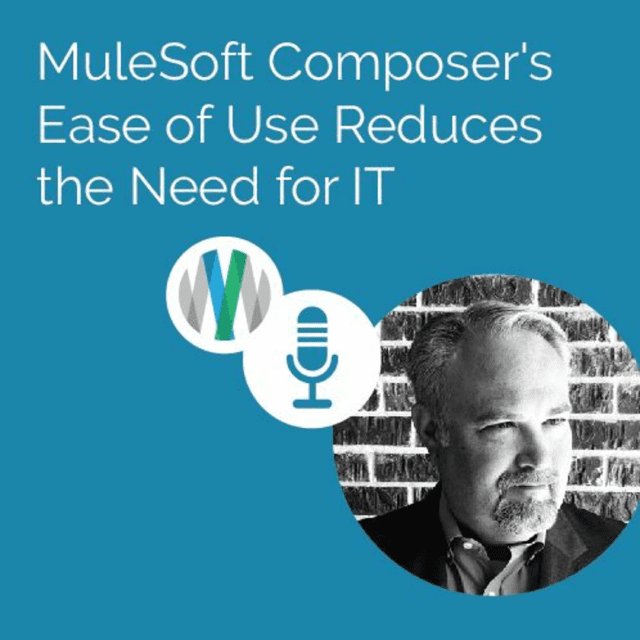Mike Boyle:
All right. Let’s talk about some of the things that MuleSoft Composer can do. How does it help automate a business’s inventory process, for example?
Tom Minton:
I mentioned that there were 14 connectors that are available. One of which you’ve got Workday. You’ve got ServiceNow. You can set up an integration, say you had your, your sales team is out in the field. They can use the Salesforce app. They need to see if there’s enough widgets to sell this customer and you can set up an integration where they can go see how many items there are. You can also set up, for example, say, there’s a Slack notification that goes out to the sales team or to procurement when there’s X number of widgets left. You can automate that process and it just, it streamlines it. Streamlines it. Excuse me. You don’t have to sit and wait. You don’t have that, “Oh my gosh. I sold ten and we only have eight,” sort of situation and see its results in a better customer experience.
Mike Boyle:
Can you talk a little bit about how MuleSoft Composer helps mitigate sales forecast risk?
Tom Minton:
Yeah, I mentioned the NetSuite integration. You can tie into that. There’s also Tableau. There’s a Tableau connector. You can pull that data into some reporting and some charting and see historical data and use it in such a way that you can kind of predict what’s going to happen next month, next quarter, next year, based on previous performance. That data can come … I mentioned NetSuite. I mentioned Workday, but it can come from something as simple as Google Sheets. If you have one of the most abused business softwares out there is Excel. Everybody uses Excel probably in ways that it shouldn’t be used, but let’s say you have a bunch of data that you need to chart on something. You can save that Excel is a Google sheet. You can then integrate that Google Sheet to Salesforce or to Tableau or to something like that and actually map that data out in a much more usable and visual way. That’s one of the best benefits of that particular connector.
Mike Boyle:
It’s my understanding, Tom, that MuleSoft Composer synchronizes with multiple Salesforce orgs. Talk about how that can be beneficial to a company?
Tom Minton:
You’ve got your widget company. You’re trucking along and you’re doing so well that maybe one of your competitors, you come together. You acquire someone else who says it has their own Salesforce org. You’re able to actually integrate those two orcs using Composer with the Salesforce connector on each end and pass information back and forth that way. Now, instead of having to swivel from one system to the other, or log out and log into another, you can synchronize those orgs using that Composer flow, set up by your administrator, and keep on going.
That’s one of the main use cases that we have in the practice with our full blown MuleSoft Anypoint Platform is getting multiple data sources into one. That’s the whole idea of MuleSoft. A lot of times it will come from acquisitions. They have their own set of data, their own set of tables or whatnot, and put them together. This is just a way that it can be done quickly. You have a Salesforce to Salesforce kind of way with literally clicks.
Mike Boyle:
In what ways could sales teams streamline operations with MuleSoft Composer? If you could talk about some of the richer sales insights that they’d be able to unlock.
Tom Minton:
You could have inventory information. You can view the throughput. You can handle your orders and you can do so in such a way that there’s an automated air to it that you can tie into Slack. Slack is really fast becoming one of the major business tools for notifications, for communications. You’re able to send information out about a new opportunity via Slack message. In that Slack message, it could have a link back to the Salesforce opportunity for whether your salespeople are in house or on the road.
Some of the other available connectors are there’s a connector for a service called Stripe, which is a cash recon ecommerce tool. You can get the information into the systems that it needs without having to type it, I guess, is a way to put it. It streamlines everything. I mean, less keyboard time, it goes more time out there making sales.
Mike Boyle:
Maybe just go a little bit deeper into that. It comes, MuleSoft Composer, with a host of prebuilt connectors to integrate Salesforce tools, such as Slack and we talked about Tableau, WorkDay, Google Sheets. The benefits of those integrations for sales operations and team collaboration. Talk a little bit more about that.
Tom Minton:
You’re able to integrate so that you’ve got multiple sources of customer information, let’s say. You pull out information into one contact or account record within Salesforce. Some of the other connectors available are Twilio. You can use that for your sales team. If you have a service-based business, as a ServiceNow, you can track your calls.
The best part is all of these … These are just the first wave. They’re coming out every three to six months with a new set. I believe the last six that they created, they dropped about a month ago. It’s a growing tool set that, again, doesn’t take a lot, if any, special training, special skills. I can tell you that skilled MuleSoft developers are not easy to come by. This is a way that you can mitigate some of those HR and staffing issues with your already existing team of Salesforce administrators and get the I don’t want to say a lighter version, but get what you’re very likely going to need from MuleSoft in a much more efficient package.
Mike Boyle:
It kind of leads me, Tom, into how I wanted to wrap things up today. To just get your final thoughts about three things, composers, ease of use, its flexibility and its scalability. How would you wrap all those three things into one big bow?
Tom Minton:
I would say, going back to the clicks, not code tagline that they have, it just makes integration easier. It makes the integration something that is not something you need a team for. It’s something that your staff can already do. The ease of use, it’s drag and drop. It’s you who says, “Hey, this is the key for this,” and all of a sudden the systems are not talking to each other. They’ve made that probably one of the … I believe when they were designing it, they had that idea in mind of can the Salesforce admin, super-user type resource actually make this happen. I believe they’ve hit a home run with that.
As far as flexibility, it’s really, at this point, there’s some limitations into what you can connect to. It covers almost all of the common business software, but the flexibility comes in that as users say, “Hey, I need to be able to connect to X.” There might be next drop, there might be an SAP connector, or there might be a true SQL connector or something where you can get into other systems you can’t currently get to now. MuleSoft is very big on wanting to connect everything. That’s a big driver in their innovation. I see the best example of flexibility just being the array of options you have and even more on the way.
Then scalability is let’s say you are a Composer user and you found that you’re able to do the vast majority of your integration work through that. But, you need a little more. You need some custom transformations done, or you need to get to an AS400 and the connector’s not available yet, or some sort of in-house Oracle database. Something like that. Then you have the scalability to then talk to MuleSoft, like, “Hey, can we maybe move on to the enterprise edition, Anypoint Platform?”
I believe, I would say, don’t quote me on that, but you’re recording me. I’m sure that there is going to be some sort of way to connect your Composer integrations to integrations within the Anypoint Platform but I haven’t seen that yet. It would really surprise me if that isn’t at least on somebody’s radar. That kind of gives you scalability. You can start small with Composer. You can kind of get into the MuleSoft ecosystem and then really see how it benefits you, how it grows your business, how it just makes things easier.
Mike Boyle:
He’s Tom Minton. He’s Ad Vic’s MuleSoft Practice Director. Tom, I want to thank you for joining us today and taking this under the hood of this animal called MuleSoft Composer for Salesforce. I know we’ll have you back again. There’s a plethora of MuleSoft topics that we can have you back for. We look forward to that. Thanks again, Tom.
If you would like to learn more about a MuleSoft or Salesforce solution for your business, you visit our website. It’s advic.com, A-D-V-I-C dot com. We just got some big news about this podcast. In addition to the usual podcast platforms you get us on, you can now listen to us on Facebook from the podcast tab on your mobile device’s app, both iOS and Android. Can’t listen to it on the desktop version of Facebook yet. We’re told that they’re working on that. Check us out on your Facebook app when you have the opportunity.
I’m Mike Boyle from Ad Victoriam Solutions. I want to thank you for joining us for our latest edition of Salesforce Simplified, which, again, you can follow on all the podcast platforms out there. Our next episode is just around the corner.


